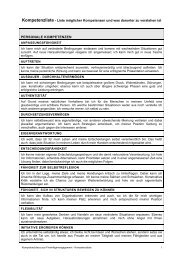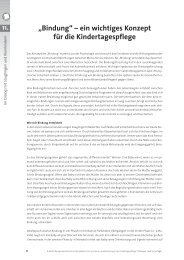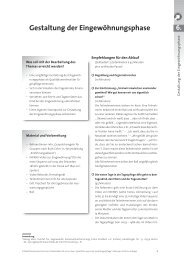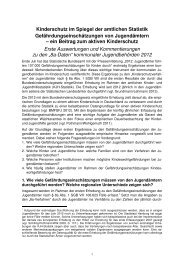download - Deutsches Jugendinstitut e.V.
download - Deutsches Jugendinstitut e.V.
download - Deutsches Jugendinstitut e.V.
You also want an ePaper? Increase the reach of your titles
YUMPU automatically turns print PDFs into web optimized ePapers that Google loves.
120<br />
2. National action strategies and programmes must contain sufficient scope<br />
and competencies for local implementation.<br />
National strategic guidelines and programmes are implemented in regions and<br />
municipal areas. Local actors must accommodate concrete problem complexes and<br />
needs on a local level and be able to test and undertake specially tailored methods<br />
for the realisation of national strategies. These actors must be provided with<br />
sufficient scope for the local implementation of national action strategies which can<br />
be flexibly adapted to local needs. Furthermore, national action plans can only be<br />
effective if sufficient potential is available on a local level. Here the competencies<br />
for project application and local project management must be supported and<br />
strengthened.<br />
3. Action strategies and measures must be developed and implemented<br />
transversally.<br />
The development and implementation of strategies and measures for the<br />
improvement of the situation of young persons in disadvantaged neighbourhoods<br />
is – like the general field of child and youth politics – a cross-functional task which<br />
must be approached transversally. All involved and associated departments such as<br />
education, employment, social integration, migration, urban development and<br />
youth affairs must be involved in the compilation and implementation of national<br />
integration strategies.<br />
4. Action strategies and programmes must be developed and implemented in<br />
partnership.<br />
Additionally, the strategic and participative involvement of all social partners and<br />
actors is imperative. This includes not only youth welfare and youth career services<br />
but also NCOs and small local initiatives, the business sector and employees’<br />
representatives and ultimately the young persons themselves with their families.<br />
5. Measures and programmes must take into consideration and involve the<br />
entire personal sphere and wider environment of children and young<br />
persons.<br />
Measures and programmes for the integration of children and young persons must<br />
involve their entire surrounding environment: childcare, school, professional<br />
training and businesses, infrastructure and transport structure, neighbourhood,<br />
leisure facilities and friends, but also the family. Socio-environmental measures can<br />
aid the development of ideally suited projects for problems within the urban district<br />
without the necessity of selecting an initial target group. These measures examine<br />
the entire social environment of children and young persons in a particular area and<br />
are especially suited to comprehensive integration projects. Target-group based<br />
approaches are suitable for measures directed at specific target groups. On a<br />
European level, both socio-environmental and target-group based approaches have<br />
met with success and these two approaches can therefore be recommended. The<br />
combination of both approaches has proved to have been particularly promising.

















